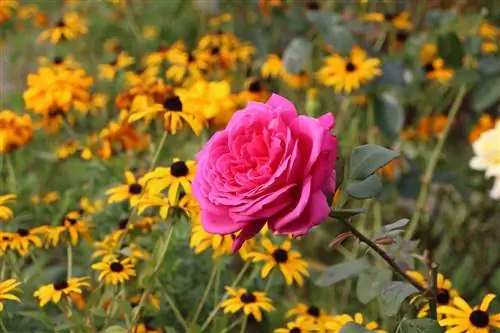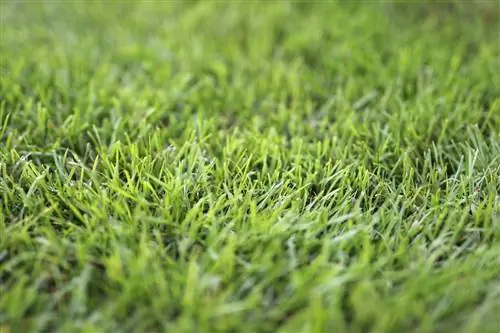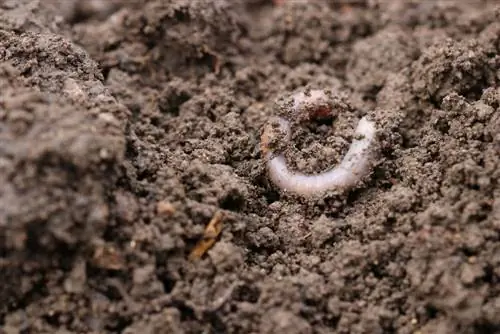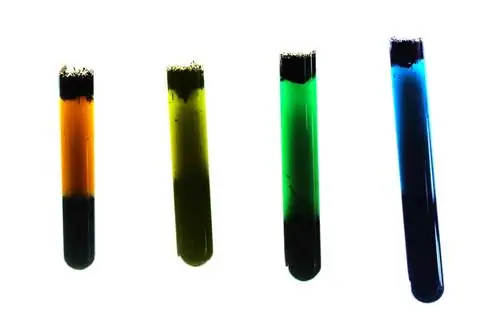- Author admin [email protected].
- Public 2023-12-17 03:39.
- Last modified 2025-06-01 06:48.
When blue hydrangeas change color, soil and water play a crucial role. With the right factors, pink-flowering hydrangeas can even be dyed yourself. In addition to the right knowledge, this also requires some patience, because the plants need some time for the seemingly magical change. However, if attention is paid to the pH value and it is adhered to, a radiant blue can be achieved and maintained. Plays of colors in different tones - especially in the plant pot - are also easily possible and are guaranteed to catch the eye.
Coloring
Pink, white or blue - when buying, many people choose the unusual blue hydrangeas. However, these do not appear as a constant color in hydrangeas. Rather, they are actually pink-flowering plants that change color in connection with certain water and soil conditions. However, unlike what is known for cut flowers and dyes in water, this process takes place over a longer period of time. It can take up to two years before the flowers shine exclusively blue. If you want to maintain the blue tint permanently, you should pay close attention to the substrate and irrigation water and only use the appropriate pH values. Otherwise, gradual discoloration will occur. This shade can be played wonderfully if the decisive factors are known.
Tip:
If you want to color a hydrangea blue or purple, you should use a pink flowering plant as a starting point. Change is only possible with these.
Selection
In addition to the right starting color, i.e. pink, the right varieties must also be chosen. Farm hydrangeas, garden hydrangeas and plate hydrangeas are suitable. Cultivated forms with false flowers, especially fringed varieties, are quicker and easier to recolor than others. If you want to dye yourself and don't want to wait too long for success, you should use these.
Correct pH value
The pH value of hydrangeas is crucial for the success of dyeing or maintaining the color blue. This must be between 4 and 4.5 if a radiant blue tone is to be achieved. Regular tests and the exclusive use of water and soil with these values are therefore crucial for long-term success. The fertilizer and all fertilizers must not push the pH value into the alkaline range. So a little caution, effort and knowledge is required here.
Tip:
The right pH value is easier to maintain in the long term in a bucket or flower pot than when planted freely in the garden.
Earth
The easiest way to keep or color hydrangeas blue is to plant them in rhododendron soil. This substrate already has the appropriate pH value of 4 to 4.5. Mixtures, tests and other measures are therefore not necessary. However, for larger beds, this special soil is often quite expensive, especially if the pH value increases over time. And this occurs automatically due to rain, clogging of other substrates and washing out. A barrier, for example through lawn edges, can help here. However, it doesn't have to be rhododendron soil, as there are other alternatives for blue hydrangeas. To do this, however, it is necessary to mix the soil yourself. The pH value mentioned above is crucial. This can be achieved with the following procedure and the means mentioned:
- First, the current pH value of the substrate - ideally compost soil - must be determined in order to estimate how much it needs to be acidified. Test strips are available for this purpose. However, a professional determination of the value can also be carried out, for which a soil sample is sent to an appropriate soil analysis center or, for example, to a hardware store or garden center.
- If the pH value of the soil is significantly above 4.5 - i.e. it is not acidic enough - it should be provided with appropriate acidifying agents. The addition of sand and peat is a good idea, as this results in a quick reduction in the value. However, peat is ecologically questionable as peat is destroyed when it is mined. Alternatives are therefore to be preferred. Rotting oak leaves, chopped conifers or needles themselves, hazelnut branches and grape pomace or fertilizer made from these are suitable. Compost made from these substances is optimal.
- The selected agent is mixed well with the soil and this combination is then moistened.
- After about a week, the soil pH should be tested again. If these are substances that are still rotting, the pH value will decrease more slowly but over a longer period of time. For faster changes, already decomposed agents should be used.
- Depending on the results of the test, additional acidifying agents may need to be added. So it continues to be mixed until a value between 4 and 4.5 is reached.
This procedure requires some patience. Therefore, vinegar is still recommended for acidifying the soil and in fact it can lower the pH in a very short time. However, this measure is not recommended to dye the hydrangeas blue or to preserve their color in the long term.
Tip:
Another possible alternative is the use of fertilizers that have an acidifying effect on the substrate. These include, for example, azalea, rhododendron and hydrangea fertilizers.
Water
The soil may initially have the ideal pH value, but gradually become too alkaline for blue-flowering hydrangeas. This is often due to the water being too hard or the limescale in it. Watering, like the substrate, is a crucial factor in coloring the hydrangea blue or maintaining the blue throughout. It is optimal to only use soft water. The easiest source of this is rain, which is collected in tons. If this option is not available, you should use the test strips or ask the relevant waterworks about the hardness of the tap water. If it is very soft and contains hardly any lime, it can be safely used to water the blue hydrangea. However, if it is hard, it should first be left in a jug or bucket for a week. The lime contained in it settles at the bottom of the vessel. As long as the water is not stirred up, it can also be used for watering. Filtered water can be used as another alternative.
Time
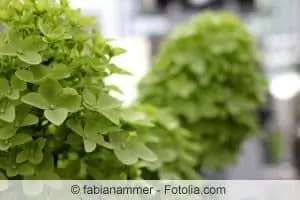
If a pink blooming hydrangea is used as an exit, a little patience is required when changing the color. Even if the pH values of the water and soil are correct. At first the flower will take on a lilac color and gradually become more and more bluish. A violet color is often achieved initially. Only then do the blue flowers appear. This is not complicated in itself, but it can take one to two years. Especially if the plant is not placed directly in substrate with a low pH value, but is only gradually lowered, the process takes longer.
Fertilizer
In addition to the pH values of the soil and water, aluminum oxide in the soil is also important for blue hydrangeas, as this compound is partly responsible for the color. In order to provide this in sufficient quantities, appropriate fertilization must be carried out. Special fertilizers are suitable for hydrangeas. But products for azaleas and rhododendrons can also be used. Universal fertilizer or other products with a high phosphorus content, however, quickly make the blue flowers appear pink.
Conclusion
With a little patience and the right soil, it is easily possible to create blue hydrangeas or to keep blue-flowering specimens in the desired tone. If you have the appropriate knowledge and pay attention to the pH value of the soil, water and fertilizer, you can even play with the color of the flowers and create so many variations.


